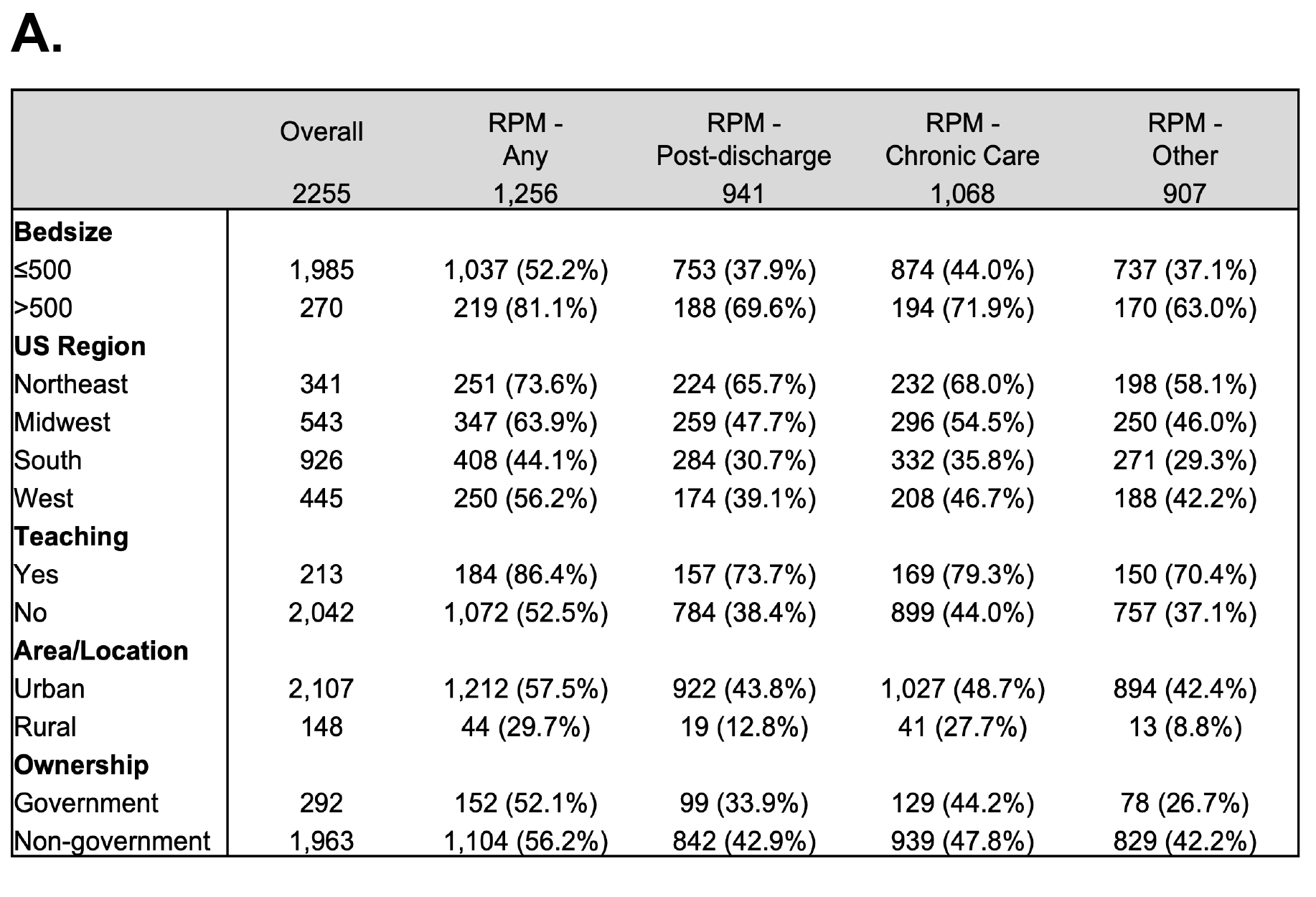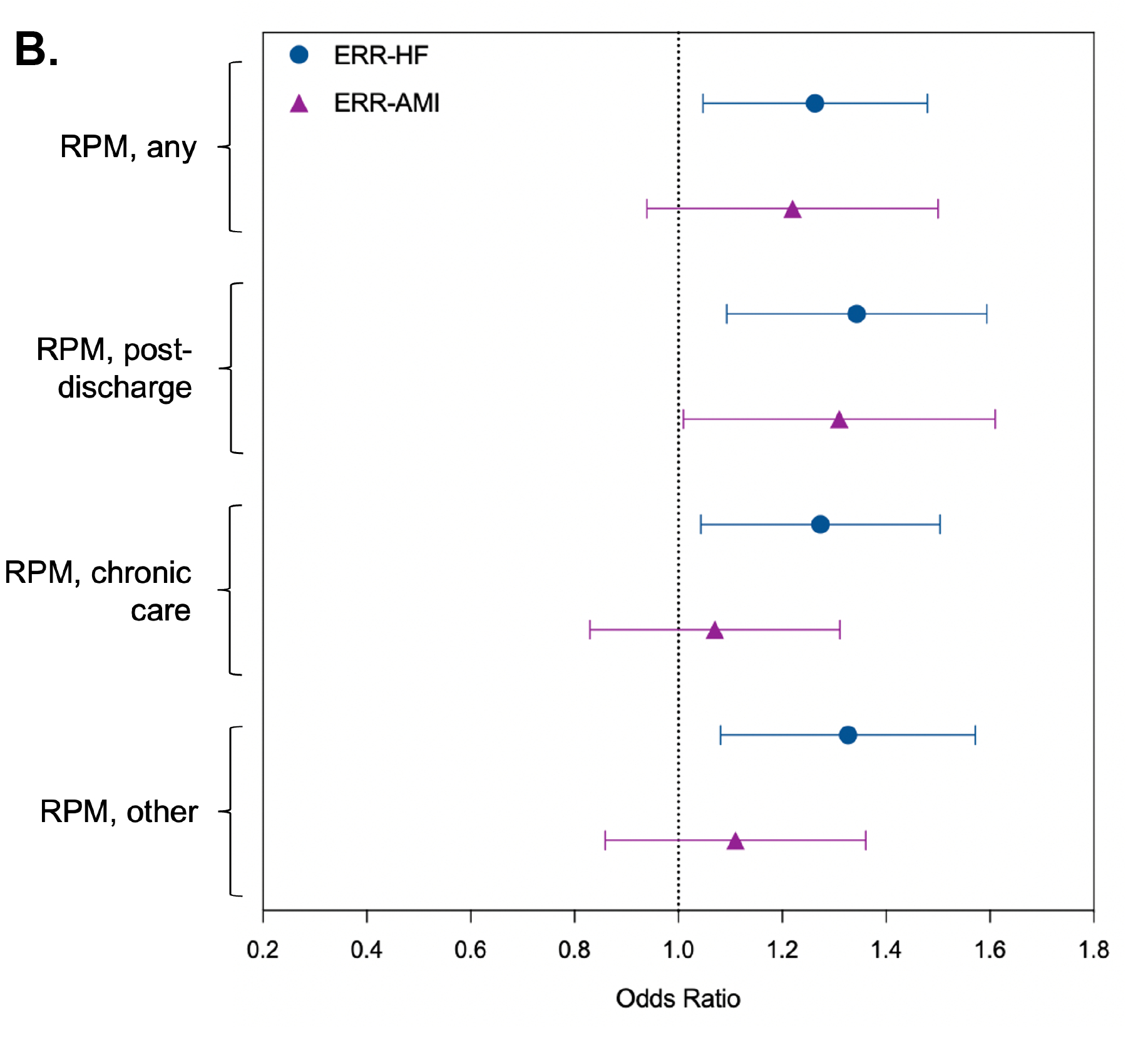Final ID: 4142835
Remote Patient Monitoring and Excess Readmission Rates for Cardiovascular Conditions at Hospitals in the United States
Abstract Body (Do not enter title and authors here): Background: Heart failure (HF) and acute myocardial infarction (AMI) have been a key focus of health policy initiatives targeting hospital readmission risk, but after initial improvements, progress has slowed. Digital remote patient monitoring (RPM) tools have been recognized as potential strategies for enabling better patient outcomes by tracking healthcare outside clinical settings. We evaluated patterns of RPM service use at US hospitals and their association with post-discharge outcomes for HF and AMI.
Methods: We used the 2022 American Hospital Association (AHA) Annual Survey data to identify US hospitals offering RPM services and the nature of these services (post-discharge, chronic care, others), overall and across different hospital groups (based on bed size, location, ownership, teaching status, and region). We linked these with hospitals’ benchmarked risk-standardized relative performance on readmissions (excess readmission ratio [ERR]) from CMS Hospital Quality Report (2019-2022) to examine the association between RPM services at hospitals and lower than expected HF and AMI readmission rates (ERR<1), accounting for hospital characteristics in multivariable logistic regression.
Results: The study included 2,255 hospitals in the AHA Survey with paired readmission performance data. Of these, 55.7% offered RPM services: 41.7% for monitoring post-discharge care, 47.4% for chronic care management, and 40.2% for other RPM services. RPM service availability was highest at hospitals with bedsize ≥500 (81.1%) and those in the Northeast (73.6%). RPM services were also more frequently available at urban vs rural (57.5% vs 29.7%) and teaching vs non-teaching (86.4% vs 52.5%) hospitals (A). Hospitals with RPM services compared with those without RPM services were more likely to have an ERR<1 for HF (OR 1.24, 95% CI 1.03-1.49) but not for AMI (OR 1.20, 95% CI 0.95-1.51). However, availability of RPM services targeted explicitly at post-hospitalization monitoring was associated with greater likelihood of having an ERR<1 for both HF (OR 1.33 95% CI 1.10-1.60) and AMI (OR 1.29, 95% CI 1.02-1.62) (B).
Conclusions: Large, urban, and teaching hospitals more frequently invested in RPM services, which was associated with lower-than-expected readmission rates for HF and AMI, especially when RPM specifically targeted post-discharge care. There is a need to rigorously evaluate the nature of services that enable the best post-discharge outcomes for each condition.
Methods: We used the 2022 American Hospital Association (AHA) Annual Survey data to identify US hospitals offering RPM services and the nature of these services (post-discharge, chronic care, others), overall and across different hospital groups (based on bed size, location, ownership, teaching status, and region). We linked these with hospitals’ benchmarked risk-standardized relative performance on readmissions (excess readmission ratio [ERR]) from CMS Hospital Quality Report (2019-2022) to examine the association between RPM services at hospitals and lower than expected HF and AMI readmission rates (ERR<1), accounting for hospital characteristics in multivariable logistic regression.
Results: The study included 2,255 hospitals in the AHA Survey with paired readmission performance data. Of these, 55.7% offered RPM services: 41.7% for monitoring post-discharge care, 47.4% for chronic care management, and 40.2% for other RPM services. RPM service availability was highest at hospitals with bedsize ≥500 (81.1%) and those in the Northeast (73.6%). RPM services were also more frequently available at urban vs rural (57.5% vs 29.7%) and teaching vs non-teaching (86.4% vs 52.5%) hospitals (A). Hospitals with RPM services compared with those without RPM services were more likely to have an ERR<1 for HF (OR 1.24, 95% CI 1.03-1.49) but not for AMI (OR 1.20, 95% CI 0.95-1.51). However, availability of RPM services targeted explicitly at post-hospitalization monitoring was associated with greater likelihood of having an ERR<1 for both HF (OR 1.33 95% CI 1.10-1.60) and AMI (OR 1.29, 95% CI 1.02-1.62) (B).
Conclusions: Large, urban, and teaching hospitals more frequently invested in RPM services, which was associated with lower-than-expected readmission rates for HF and AMI, especially when RPM specifically targeted post-discharge care. There is a need to rigorously evaluate the nature of services that enable the best post-discharge outcomes for each condition.
More abstracts on this topic:
A Case Presentation of Severe Left Ventricular Dysfunction from Focal Myocarditis due to Immune Checkpoint Inhibitor
Patel Romil, Hussain Kifah, Gordon Robert
Associations Between Trust in Health Information Sources and Perceptions on the Modifiability of Stroke and Dementia Risks Using a U.S. Based CohortNg Sharon, Ibrahim Sarah, Towfighi Amytis, Van Duijn Cornelia, Fricchione Gregory, Tanzi Rudolph, Yechoor Nirupama, Anderson Christopher, Rosand Jonathan, Singh Sanjula, Senff Jasper, Maulik Meara, Tack Reinier, Tan Benjamin Yong Qiang, Pouwels Koen, Nunley Courtney, Shah Ostrowski Mark Jun, Pikula Aleksandra


